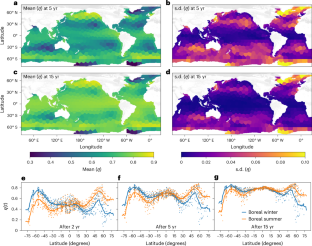Mapping the global variation in the efficiency of ocean alkalinity enhancement for carbon dioxide removal
IF 29.6
1区 地球科学
Q1 ENVIRONMENTAL SCIENCES
引用次数: 0
Abstract
To limit global warming to below 2 °C by 2100, CO2 removal from the atmosphere will be necessary. One promising method for achieving CO2 removal at scale is ocean alkalinity enhancement (OAE), but there are challenges with incomplete air–sea CO2 equilibration, which reduces the efficiency of carbon removal. Here, we present global maps of OAE efficiency, and assess the seasonal variation in efficiency. We find that the equilibration kinetics have two characteristic timescales: rapid surface equilibration followed by a slower second phase, which represents the re-emergence of excess alkalinity that was initially subducted. These kinetics vary considerably with latitude and the season of alkalinity release, which are critical factors for determining the placement of potential OAE deployments. Additionally, we quantify the spatial and temporal scales of the induced CO2 uptake, which helps identify the requirements for modelling OAE in regional ocean models. Ocean alkalinity enhancement (OAE) is seen as a promising method for CO2 removal as it alters the surface carbon equilibrium, driving the transfer of CO2 into the ocean. Here the authors computationally map the spatiotemporal efficiency of OAE to identify locations and timing for optimal OAE deployment.


绘制海洋碱度提升去除二氧化碳效率的全球变化图
要在 2100 年前将全球变暖控制在 2 °C 以下,就必须从大气中去除二氧化碳。海洋碱度增强(OAE)是实现大规模二氧化碳去除的一种可行方法,但由于海气二氧化碳平衡不完全,降低了碳去除的效率。在这里,我们展示了全球 OAE 效率图,并评估了效率的季节性变化。我们发现,平衡动力学有两个特征时间尺度:快速的表面平衡,随后是较慢的第二阶段,这代表了最初潜入的过量碱度的重新出现。这些动力学随纬度和碱度释放季节的不同而有很大差异,这是确定潜在 OAE 部署位置的关键因素。此外,我们还量化了诱导二氧化碳吸收的空间和时间尺度,这有助于确定在区域海洋模式中模拟 OAE 的要求。
本文章由计算机程序翻译,如有差异,请以英文原文为准。
求助全文
约1分钟内获得全文
求助全文
来源期刊

Nature Climate Change
ENVIRONMENTAL SCIENCES-METEOROLOGY & ATMOSPHERIC SCIENCES
CiteScore
40.30
自引率
1.60%
发文量
267
审稿时长
4-8 weeks
期刊介绍:
Nature Climate Change is dedicated to addressing the scientific challenge of understanding Earth's changing climate and its societal implications. As a monthly journal, it publishes significant and cutting-edge research on the nature, causes, and impacts of global climate change, as well as its implications for the economy, policy, and the world at large.
The journal publishes original research spanning the natural and social sciences, synthesizing interdisciplinary research to provide a comprehensive understanding of climate change. It upholds the high standards set by all Nature-branded journals, ensuring top-tier original research through a fair and rigorous review process, broad readership access, high standards of copy editing and production, rapid publication, and independence from academic societies and other vested interests.
Nature Climate Change serves as a platform for discussion among experts, publishing opinion, analysis, and review articles. It also features Research Highlights to highlight important developments in the field and original reporting from renowned science journalists in the form of feature articles.
Topics covered in the journal include adaptation, atmospheric science, ecology, economics, energy, impacts and vulnerability, mitigation, oceanography, policy, sociology, and sustainability, among others.
 求助内容:
求助内容: 应助结果提醒方式:
应助结果提醒方式:


